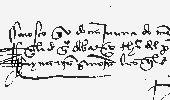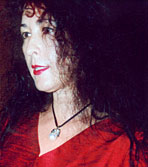La differece of being woman
Research and Teaching of History
Area: Essays
The Two Infinites: The Primary Material and God María-Milagros Rivera Garretas.
María-Milagros Rivera Garretas.
Introduction
The History that is written has, in general, the intention of relating and interpreting human experience in time. In time, the human creature that is the protagonist and that lives through history does not present itself as an abstract being or person, but rather as a woman or a man; because the human creature is sexed, always and everywhere.
That in the world, there are and there are only women and men, little girls and little boys, we learn upon learning to speak. On teaching us to speak –that is, on teaching us the mother tongue-, the mother teaches us to refer to little girls in the feminine and to little boys in the masculine. Perceiving the fact of sexual difference, we learn to observe and appreciate history as a whole, given that the world is enriched by the interpretations and free expressions of being woman and being man: a human and irreducible, human quality, which marks everything.
On the irreducible nature of the difference of the sexes: Librería de Mujeres de Milán, El final del patriarcado. Ha ocurrido y no por casualidad, trans. by María-Milagros Rivera Garretas, Barcelona, Llibreria Pròleg, 1996.
However, when we read a scientific work of History, we see that its author or its authoress almost never speaks in feminine and in masculine but rather in neutral: in that supposedly universal neutral that feminism, so strongly and so rightly denounced and which the positivism of the nineteenth century has imposed as scientific language. They are works of history that do not register –separating themselves thus from the mother tongue learned in infancy- the fundamental historical fact which is that history is made and lived through by women and men. Because of this their books have titles such as Medieval Man or The Philosophy of Man or The Indian Men of the Caribbean or The Little Boy in Renaissance Literature.
They do not do so out of a matter of economy of language nor lack of space, since generally they are works that extend themselves in all kind of details of only moderate interest, but rather because of a political question: from Humanism and the Renaissance, the culture that is called western has persistently hounded the free expressions of the difference of being woman in history; trying, on the other hand, against all evidence of the senses, to make the neutral language include women as well. But, as by chance the neutral language is not neutral but rather coincides with masculine language, when a woman reader approaches a scientific work of history with the hope of knowing something about her past, the opaqueness is total. In it, women do not see themselves because masculine language deprives us of our own infinite.
There is, then, today, between history and scientific books of history, between life and historiography, a fundamental disconnection, a hole though which many things escape: so many, that more and more people prefer to read a historical novel rather than an essay in order to know an episode of the past. The disconnection consists in the fact that the foundation of living history is the relationships of the sexes, and, on the other hand, the foundation of the scientific works of history is the actions of a supposedly universal neutral man: a strange man, who is, in reality, neither man nor woman.
Sexual Difference in History
However, outside the places governed by scientific positivism, women have always written history taking into account the free sense of their being woman. They have done so above all in the amongst-women, be this in the convents and monasteries, in the institutions of canonesses, in the world of the beguines and beatas, in the feminine courts of royalty, of the nobility and of the bourgeoisie, in feminist groups, in dual relationships embarked upon and sustained in any place and time, in the cultural, educational foundations or feminine politics, etc. The texts of the troubadour Anonymous 2, of Christine de Pisan and of Teresa de Cartagena, are a few examples of it.
In their tales of lived histories, they wrote in feminine in order to refer to women and in masculine to refer to men. With this political gesture expressed in language, they left open to both women and men their own infinite dimension, an infinite dimension in which freedom is possible.
To say that each sex has its own infinite means to understand that in the world there existtwo infinites, the feminine and the masculine. This clashes with the present day custom of taking for granted, without thinking much about it, that the infinite is only one, as God is only one or only one the peak or only one the president or the principle of thought or of being. And yet, the cosmogony of feudal Europe was formed around two creating principles, each one of which was understood as being of cosmic reach. These creating principles were the feminine principle and the masculine principle. This way of seeing the world expressed itself, for example, in a theory which is called the the doctrine of the two infinites. This doctrine said that in the world there are two infinites, which are: the primary material or materia prima and God. The primary material is the feminine creative principle, God is the masculine creative principle.
Paolo Lucentini, L’eresia di Amalrico, in Werner Beierwaltes, ed., Eriugena redivivus. Zur Wirkungsgeschichte seines Denkens im Mittelalter und im Übergang zur Neuzeit, Heidelberg, Carl Winter – Universitätsverlag, 1987, 174-191. Guy-H. Allard, L’attitude de Jean Scot et de Dante à l’égard du thème des deux infinis: Dieu et la matière première, Ibid., 237-253. María-Milagros Rivera Garretas, Una cuestión de oído. De la historia de la estética de la diferencia sexual, in Marta Bertran Tarrés, Carmen Caballero Navas, Montserrat Cabré i Pairet, María-Milagros Rivera Garretas and Ana Vargas Martínez, De dos en dos. Las prácticas de creación y recreación de la vida y la convivencia humana, Madrid, Horas y horas, 2000, 103-126. Teresa Gràcia Sahuquillo has also studied it in works that unfortunately have not been published.
This theory, attached to life in its sexuation, was persecuted from the thirteenth century by the catholic ecclesiastical hierarchy, which used for it the scholastic, the universities, torture and the death penalty.
The doctrine of the two infinites was, in its amalriciana version, condemned by the IV Concilio de Letrán (1215). The version of the theology in the mother tongue –Guillerma de Bohemia, Margarita Porete, for example-, that used the expression “enGodded”, was condemned by Saint Thomas Aquinas, who ridiculed those who said “totum mundum esse Deum”, he himself confusing the otherness that is inside the human creature with the pretension of being God herself. Margarita Porete was burnt to death in the Place de la Grève of Paris in 1310.
Some women made of themselves, however, the depositaries of the memory of the doctrine of the two infinites and, in different ways according to their historical circumstances, they remembered it in their writings throughout the following centuries, until the present-day.
Teaching suggestions
With the objective of perceiving the up-to-date nature of the theory or doctrine of the two infinites, it could be interesting to read and discuss a fragment of the novel of Clarice Lispectorentitled Cerca del corazón salvaje (1944)), in which she relives the memory of the primary material as the feminine creative principle of cosmic reach. Because the theory of the two infinites helps to unravel an enigma of the politics of our time, an enigma that is expressed with the metaphor of the “glass ceiling”. The glass ceiling appears when a woman cannot achieve something –something that she desires- because it happens that she is not a man: something –being a man- that she could not, in substance, become, although she may emulate it or seem it. In a politics that coincides with the theory of the two infinites, there is no glass ceiling, given that neither the woman is understood as the measure of the man, nor is the man understood as the measure of the woman: she would have her own infinite, he, his.
“What did her divinity lie in at the end of the day? The shadow of that knowledge that is not acquired with the intelligence speaks even in the less gifted. Intelligence of the blind things. Power of the stone that on falling pushes another that ends up falling in the sea and kills a fish. Sometimes the same power was found in women who were recently mothers and wives, timid women of the man, like aunt, like Armanda. And yet, they had a great strength, unity in weakness… Perhaps she was exaggerating, perhaps the divinity of women was not specific and was only in the fact that they existed. Yes, yes, there was the truth: those women existed more than the other ones, they were the symbol of the thing in the thing itself. And the woman discovered that she was a mystery in herself. There was in all of them a quality of primary material, some thing that could end up defining itself but that never ended up doing so because its very essence was that of “change”. Was it not exactly through her that the past was joined to the future and to all times? And, further on: Do not exaggerate its importance, in all women’s bellies a child may be born. How beautiful and how woman she is, serenely primary material, in spite of all the other women!" (Cerca del corazón salvaje [Near to the Wild Heart], trans. by Basilio Losada, Madrid, Siruela, 2002, pp. 143 and 145).
Images

Lady playing the harp

A lady minstrel

Christine de Pisan writing in her study

The Three Virtues –Reason, Rectitude and Justice- appear to Christine de Pisan

Construction of the walls of the Cité des Dames

Rectitude, Christine and illustrious ladies in front of the Cité des Dames

Autograph of Juana de Mendoza, written in a beautiful humanist hand (s. XV)

Beginning of the book Admiración de las obras de Dios, by Teresa de Cartagena, dedicated to Juana de...
© 2004-2008 Duoda, Women Research Center. University of Barcelona. All rights reserved. Credits. Legal note.
Credits
Scentific Direction: Maria Milagros Rivera Garretas
We are thankful to the Research Project from the Instituto de la Mujer I + D entitled: "Entre la historia social y la historia humana: un recurso informático para redefinir la investigación y la docencia" (I+D+I 73/01) for its financial support to this project.
Institut Català de la Dona de la Generalitat de Catalunya and the Agrupació de Recerca en Humanitats de la Universitat de Barcelona for they contribution to its development (22655).
Technical Direction: Dr. Óscar Adán
Executive Production: Dr. Sonia Prieto
Edition: Marta García
Correction: Gemma Gabarrò
Catalan Translation: David Madueño
English Translation: Caroline Wilson
German Translation: Doris Leibetseder
Italian Translation: Clara Jourdan
Legal note
Copying or reproduction in whole or in part by whatever means is prohibited without express written authorization.
The texts, data and information contained in these pages are free for personal use. However, written permission from Duoda, Women Research Center is required for their publication in any medium or for their use, distribution or inclusion in other contexts accessible to third parties.
© 2004-2008 Duoda, Women Research Center. University of Barcelona. All rights reserved.
